Blog by Steve Laug
When I saw this pipe on Ebay I decided I wanted to have it in the collection. The seller said the stem was amber and it may be though I am thinking it is more of an Amberoid. The bowl had a fill on the back left side at the shank bowl junction. The band on the shank was rotated to the right and a little loose. The finish was worn and dirty. The rim was covered in tars and lava and the bowl was caked and half filled with the last unfinished bowl of tobacco. There was no information from the seller as to stampings or markings on the bowl or shank. It appeared to be a no name pipe. The seller thought the stem was horn or amber but it did not look like that to me. The stem looked to be in decent shape though it had tooth marks on the top and the underside near the button. The stem was very dull in appearance and the airway was black. The case was in decent shape with a lot of ash and detritus from the years. All in all the pipe was tired but it looked to be easily restorable. The photos below came from the seller.

 The next two photos show the stem damage. It does not appear to be extensive more chatter than any deep bite marks. The way the marks look on the stem it looks to me that the stem is amberoid or Bakelite not amber or horn.
The next two photos show the stem damage. It does not appear to be extensive more chatter than any deep bite marks. The way the marks look on the stem it looks to me that the stem is amberoid or Bakelite not amber or horn.
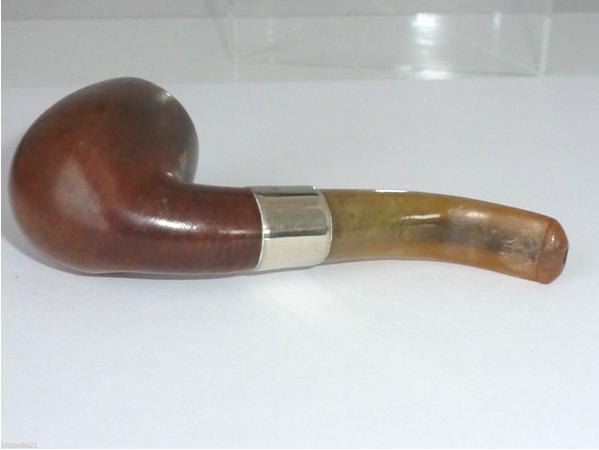 The pipe is diminutive – a small one all the way around. It is well proportioned but is 4 inches long with a bowl height of 1 ½ inches. The inside diameter of the bowl is 5/8 inches.
The pipe is diminutive – a small one all the way around. It is well proportioned but is 4 inches long with a bowl height of 1 ½ inches. The inside diameter of the bowl is 5/8 inches. The seller also included several close up photos – one of a large fill on the back left side of the bowl. It appeared to be tight and smooth but I would know more once I cleaned up the bowl. The other photo was of the metal band. It was stamped with faux hallmarks and an EP in a diamond that signified that the band was electroplated.
The seller also included several close up photos – one of a large fill on the back left side of the bowl. It appeared to be tight and smooth but I would know more once I cleaned up the bowl. The other photo was of the metal band. It was stamped with faux hallmarks and an EP in a diamond that signified that the band was electroplated.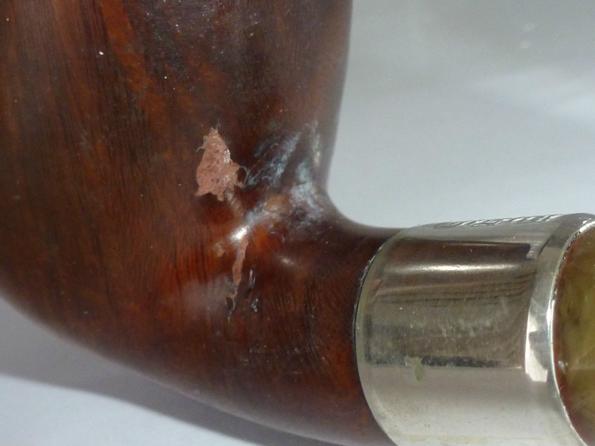
 The case was in decent shape for a pipe this age.
The case was in decent shape for a pipe this age.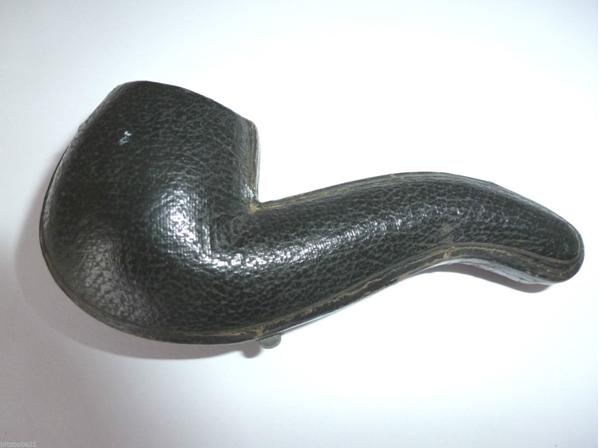 When the pipe arrived I unpacked it and took it out of the case and took a few photos of my own to confirm my assessment from the seller’s photos. The pipe was solid and clean. The finish was worn and tired – dirty but would clean up nicely. The lava on the rim and the damage to the rim edges would need some work. The stem was not amber or horn but amberoid or Bakelite. It had some interesting swirls and would clean up nicely. The material on the inside of the case had a lot of ash and was dirty but intact.
When the pipe arrived I unpacked it and took it out of the case and took a few photos of my own to confirm my assessment from the seller’s photos. The pipe was solid and clean. The finish was worn and tired – dirty but would clean up nicely. The lava on the rim and the damage to the rim edges would need some work. The stem was not amber or horn but amberoid or Bakelite. It had some interesting swirls and would clean up nicely. The material on the inside of the case had a lot of ash and was dirty but intact.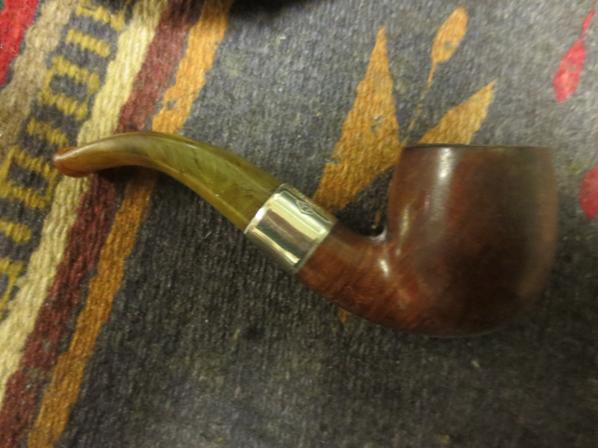



 I removed the stem from the shank and was surprised that I was able to unscrew the bone tenon from the stem. It was a little sticky but with a bit of wiggling it came free.
I removed the stem from the shank and was surprised that I was able to unscrew the bone tenon from the stem. It was a little sticky but with a bit of wiggling it came free. With the stem out I worked on the inside of the stem. The airway was almost black with tars and oils. I wanted to clean out the stem as much as possible and bring it back to a clean airway that blended with the stem material. I used alcohol, pipe cleaners and cotton swabs. The photo below shows the first stage of the cleaning. Following the scrubbing I also used Barkeepers Companion with pipe cleaners dipped in it and using that to scrub out the airways. I was able to clean out the majority of the stains.
With the stem out I worked on the inside of the stem. The airway was almost black with tars and oils. I wanted to clean out the stem as much as possible and bring it back to a clean airway that blended with the stem material. I used alcohol, pipe cleaners and cotton swabs. The photo below shows the first stage of the cleaning. Following the scrubbing I also used Barkeepers Companion with pipe cleaners dipped in it and using that to scrub out the airways. I was able to clean out the majority of the stains.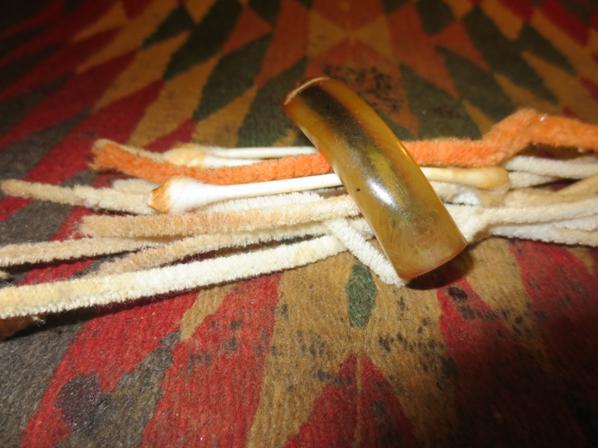
 I reamed the bowl with a PipNet reamer and took the cake back to bare briar.
I reamed the bowl with a PipNet reamer and took the cake back to bare briar. 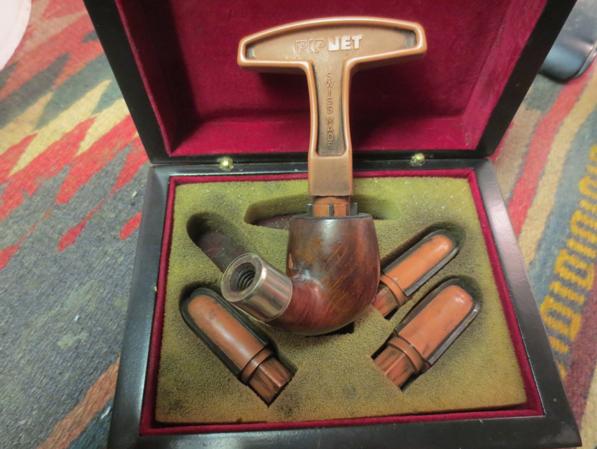
 To clean up the rim I topped it with 220 grit sandpaper. I was able to take off all of the lava and cleaned up the edges of the rim. I sanded the inside edge of the rim with a folded piece of sandpaper. I cleaned up the rough edges and the inside of the bowl.
To clean up the rim I topped it with 220 grit sandpaper. I was able to take off all of the lava and cleaned up the edges of the rim. I sanded the inside edge of the rim with a folded piece of sandpaper. I cleaned up the rough edges and the inside of the bowl.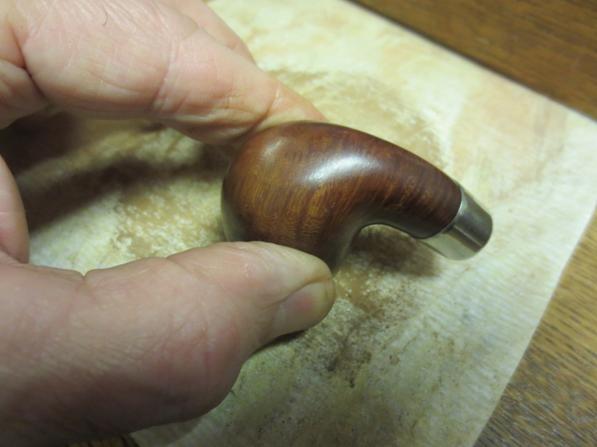

 I scrubbed the exterior of the bowl with acetone on cotton pads. It removed the finish and the grime from the bowl.
I scrubbed the exterior of the bowl with acetone on cotton pads. It removed the finish and the grime from the bowl.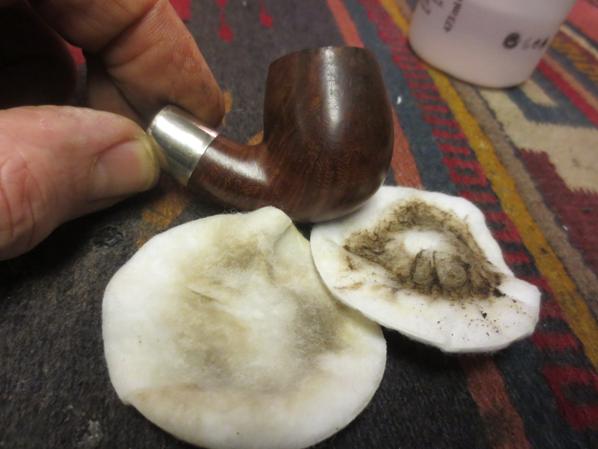

 I removed the loose band and cleaned the outside of the shank. I reglued the band with Wellbond white all purpose glue.
I removed the loose band and cleaned the outside of the shank. I reglued the band with Wellbond white all purpose glue. I cleaned out the inside of the mortise and airway with cotton swabs, pipe cleaners and alcohol.
I cleaned out the inside of the mortise and airway with cotton swabs, pipe cleaners and alcohol. I used a black Sharpie to hide the fill on the back of the bowl and then stained the pipe with Dark Brown aniline stain. I flamed it and restained and reflamed it.
I used a black Sharpie to hide the fill on the back of the bowl and then stained the pipe with Dark Brown aniline stain. I flamed it and restained and reflamed it.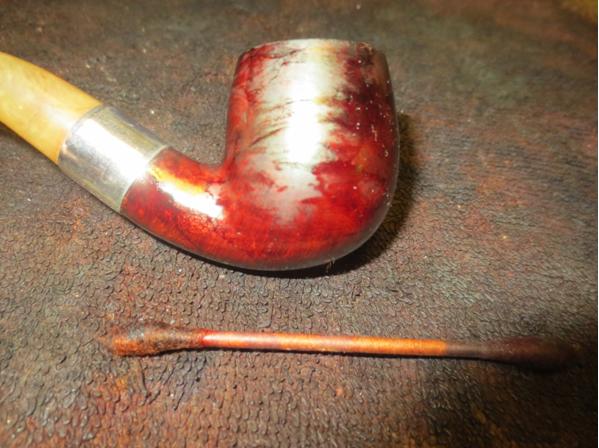


 I sanded the tooth chatter with 220 grit sandpaper to remove it. I wet sanded the stem with 1500-2400 grit micromesh sanding pads to begin the process of polishing the stem. I rubbed it down with Obsidian Oil and then dry sanded it with 3200-4000 grit pads. I gave it another coat of oil and then sanded it with 6000-12000 grit pads. I gave it a final coat of oil and let it dry.
I sanded the tooth chatter with 220 grit sandpaper to remove it. I wet sanded the stem with 1500-2400 grit micromesh sanding pads to begin the process of polishing the stem. I rubbed it down with Obsidian Oil and then dry sanded it with 3200-4000 grit pads. I gave it another coat of oil and then sanded it with 6000-12000 grit pads. I gave it a final coat of oil and let it dry.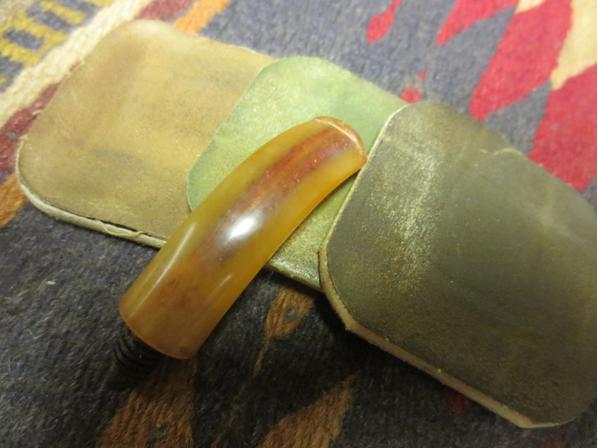

 I lightly buffed the stem and bowl with Blue Diamond and then gave the pipe several coats of carnauba wax. I buffed it with a clean flannel buffing pad and then with a microfibre cloth. I brushed out the inside of the case with the shoe brush to remove the dust and ash. The finished pipe is shown in the photos below.
I lightly buffed the stem and bowl with Blue Diamond and then gave the pipe several coats of carnauba wax. I buffed it with a clean flannel buffing pad and then with a microfibre cloth. I brushed out the inside of the case with the shoe brush to remove the dust and ash. The finished pipe is shown in the photos below.







 This is a great old pipe and one that will hold a spot in my collection. I will keep it in trust, using it and caring for it until I pass it into the hands of the next pipe man. Thanks for looking.
This is a great old pipe and one that will hold a spot in my collection. I will keep it in trust, using it and caring for it until I pass it into the hands of the next pipe man. Thanks for looking.

Moin.
I have found a pipe with similar Hallmarks / Punches at the beach of Langeoog. Langeoog is an island on the German North Sea coast. It also has an engraving in the wood. “Kaiserl. Marine” and “Imperator”. The hallmarks / punches resemble those seen on your ring of the pipe. Could you tell me more about the signs?
LikeLike
I looked to see if I could find anything out about the brand and I can find nothing in my sources. Is it possible that the Imperator reads Imperial? If so then you can get some history. Otherwise I am coming up with nothing.
LikeLike
Moin, thanks for the quick reply. No, the wood is definitely “Imperator”. This was a hospital ship of the Imperial Navy of Germany. If they want, I’d like to send you some pictures. Just know, to which mail address I should send them. Thanks in advance!
LikeLike
Very interesting info Sascha. I would love to see the pictures. My email is slaug@uniserve.com
LikeLike
Thank you! The pictures would have to reach you!
LikeLike
I found a similar pipe in my Nan’s things when we were sorting through after she had passed away. I believe it belonged to my grandad. Do you know anything more about this pipe? I’ve looked online but not found anything so far.
LikeLike
Lisa, thanks for the comment. I would love to see pictures of the pipe you found. I don’t know much more about it than what I posted here. Sorry about that.
LikeLike
Hey Steve, jumping in after Bren with some more newbie questions. In your posts most of the time you use blue diamond for polishing things up. I recall other posts (or blogs?) referring to white diamond. When do you use each? One other question: when you flame the new stain finish, what exactly are you doing? Lighting it with a match while it’s still wet? Thanks and great job in the little guy!
LikeLike
Blue diamond is one step finer than white Diamond. It is a plastic polish and it works amazingly well to raise a shine. As for flaming the stain. You got it – while it is wet I light it with a lighter. The flame burns quickly and sets the stain in the grain. It does not burn the wood. For stain I use Feibings Shoe Dye which is an aniline or alcohol based stain.
LikeLiked by 1 person
The pipe turned out very nice! I’m surprised the stem regained its former color so well.
I noticed too that either you have monster big hands of that’s a pretty small pipe?
LikeLike
It is a little guy Troy. Four inches
LikeLike
That’s cool , i like little pocket pipes. That would be a good pipe for some good ol 5 Brothers burley
LikeLike
Hello, it looks great!
I have a couple of questions based on your restoration supplies in general. I know you use micromesh pads a lot. I bought some for my boyfriend, but they were peeling after the first use. What brand do you use and where do you find them?
Secondly, I know you have mentioned using Conservator’s Wax. Basically, I have the same questions as above. Many thanks!
LikeLike
I get both online from lee valley tools
LikeLike
Thanks. I appreciate the info.
LikeLike
Bren you can also use superglue to reglue the material to the pads. Works great and extends their life
LikeLike